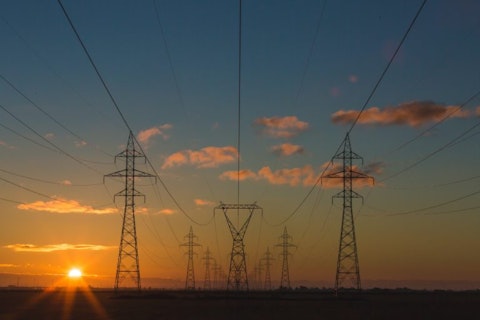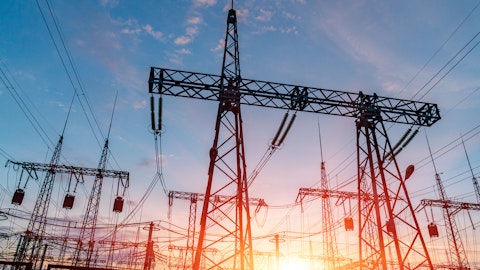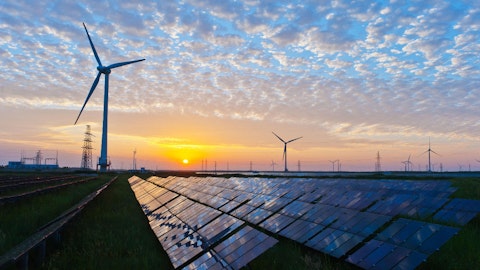Portland General Electric Company (NYSE:POR) Q2 2023 Earnings Call Transcript July 28, 2023
Portland General Electric Company beats earnings expectations. Reported EPS is $0.72, expectations were $0.48.
Operator: Good morning, everyone. And welcome to Portland General Electric Company’s Second Quarter 2023 Earnings Results Conference Call. Today is Friday, July 28, 2023. This call is being recorded, and as such, all lines have been placed on mute to prevent any background noise. After the speaker’s remarks, there will be a question-and-answer period. [Operator Instructions] For opening remarks, I will turn the conference call over to Portland General Electric, Senior Director of Finance, Jardon Jaramillo. Please go ahead, sir.
Jardon Jaramillo: Thank you, Justin. Good morning, everyone. I’m happy you can join us today. Before we begin this morning, I’d like to remind you that we have prepared a presentation to supplement our discussion, which we will be referencing throughout the call. The slides are available on our website at investors.portlandgeneral.com. Referring to slide two. Some of our remarks this morning will constitute forward-looking statements. We caution you that such statements involve inherent risks and uncertainties, and actual results may differ materially from our expectations. For a description of some of the factors that could cause actual results to differ materially, please refer to our earnings press release and our most recent periodic reports on Forms 10-K and 10-Q, which are available on our website.
Leading our discussion today are Maria Pope, President and CEO; and Trpik, Senior Vice President of Finance and CFO. Following their prepared remarks, we will open the line for your questions. Now it is my pleasure to turn the call over to Maria.
Maria Pope: Thank you, Jardon, and good morning. Before I jump into our results, I would like to introduce and welcome Joe Trpik, who joined the company in June as our new CFO. Joe brings a wealth of financial, risk management and capital markets experience. Joe’s over 20 years in senior finance roles at Exxon. So welcome. Beginning with slide four, I’ll discuss our results for the quarter and speak to key drivers. In the second quarter, we reported GAAP net income of $39 million or $0.39 per diluted share. After adjusting for the impact of Boardman, non-GAAP net income was $44 million or $0.44 per share. This compares with second quarter results of $64 million or $0.72 per share. The drivers this quarter include, regional hydro conditions, which have adversely unusually high and impacted power markets with extreme volatility.
Our load growth and higher energy usage, particularly by the semiconductor and digital sectors. Investments in long-term capital projects, including the 2021 RFP projects such as Clearwater Wind and Eastern Montana. And the prioritization of system maintenance and expenses to address ongoing reliability and resiliency. I will touch on each in turn. First, quarter-over-quarter changes to our power costs were significant. I commend our team for how well they have managed the market volatility. Last year, hydro conditions in the Columbia River Basin were about 110% to normal. This year, conditions at 80% are significantly below normal. The year-to-date impact of our power cost adjustment mechanism or PCAM, was $51 million compared to this time last year, including $23 million in the first quarter and $28 million this past quarter.
As we head into the third quarter, these large variances are expected to moderate given the seasonally low hydro generation of July, August and September. Second, we saw solid load growth. We’re seeing continued growth in high-tech sectors with increasing demand from semiconductor manufacturing, data centers and cloud computing. We’re pleased to see that during this past session of the Oregon legislature, they passed historic investments to support the semiconductor sector. These include $200 million for grant and loan programs, $255 million for R&D tax credits and $73 million foreign innovation complex at Oregon State University. Among other incentives, they also are supporting streamlined environmental land use and permitting to support the construction of new high-tech manufacturing.
We recently, in addition to Intel’s expansion, we have seen significant investments from Microchip, Lam Research and just this last week, Analog Devices announced a $1 billion investment in their operations in Beaverton, Oregon. Turning to slide five. At the end of May, we announced an agreement to procure the Evergreen battery energy storage system, a new 75 megawatt facility located in Hillsboro, Oregon. Between Clearwater Wind, the Seaside Battery project and now Evergreen, the company is investing approximately $925 million in renewable and dispatchable capacity resources as part of the 2021 RFP. In addition to these investments, we’re also looking at a number of transmission projects within our service territory and existing rights of way to help meet strong customer growth and the new manufacturing that I just noted.
In addition to cash from operations, debt and equity financing and the monetization of production and investment tax credits, we are leveraging federal IRA and IIJA funding in partnership with local communities, technology companies, tribal partners and other stakeholders. As of today, we’re pursuing over $450 million in grants to support approximately $1.1 billion in total projects for grid resiliency, cybersecurity, hydro project improvements, transportation electrification, transmission upgrades, among many other projects. As we look to the future, the 2024 general rate rise is squarely in focus. Some of our discussions have been productive and we are pleased with the constructive and collaborative progress that we’ve made to-date. PGE and parties have arrived at several agreements in principle that settle a number of items in the rate case, including a portion of PGE’s transmission and distribution capital requests, a capital structure of 50% debt and 50% equity, several business issues, such as the transfer and sale of PTCs and ITCs, and a portion of 2024 net variable power costs.
We expect to file stipulations covering these items with the OPUC in the coming weeks. And their next settlement conference is next week and we are optimistic for continued progress. As we look to the balance of the year, I’m grateful to our PGE colleagues who are working very hard every day to control costs, as we appreciate the impact we have on customer prices. We continue to expect largely flat O&M for the full year, excluding the impact of wildfire mitigation work and major deferrals. While we have much more work to do, it’s worth noting that we have front-loaded certain costs in order to reduce operating risks. Joe will touch on this more in detail in his remarks. We’re also executing on our wildfire mitigation program, which includes long-term investments and vegetation management.
We’re pleased to see the introduction of new federal legislation that would allow the U.S. foreign service to approve the removal of hazardous trees, their power lines on several florist lands. The progress that we’re making to mitigate the risk of wildfire in our service territory underscores the importance of the OPUC’s recent approval of an automatic adjustment cause for wildfire mitigation costs, enabling faster recovery. Looking ahead, execution is our watch word in 2023 and beyond, as we position the company for a period of accelerated growth. We remain confident in our 2023 guidance range of $2.60 per share to $2.75 per share, as well as our long-term earnings growth rate of 5% to 7%. With that, I’ll turn it over to Joe, who will walk you through our financial results.
Thank you.
Joe Trpik: Thank you, Maria, for the warm welcome, and good morning, everyone. I’ve hit the ground running in my first four weeks at PGE and I’m excited for the challenges and opportunities that lie ahead. Now I’ll cover our Q2 results before providing updates on our capital investments and liquidity and financing outlook. Moving to slide six. Our second quarter results reflect strong load growth trends in our region, less favorable power market conditions, prioritization of system reliability and resiliency efforts and execution of our long-term capital plan. The economy in our service territory continues to hold steady as unemployment in our region was 3.4% as of June. Demand growth among our industrial customer class remains strong and we continue to see sizable development in a healthy pipeline of upcoming projects, especially among data centers and semiconductor customers.
Q2 2023 load totals increased by 3% weather-adjusted as compared to 2022. On a non-weather-adjusted basis, total load increased 4.1% year-over-year, as we witnessed less cold weather in the early parts of the quarter, but a more warm weather later in the quarter. Residential load increased by 0.3% year-over-year but decreased 0.3% weather-adjusted as we saw warmer weather, but also more moderate population growth and increased energy efficiency and DER penetration compared to 2022. Residential customer count growth increased 0.7% compared to the second quarter of 2022. Commercial load increased 3.7% year-over-year or 1.7% weather-adjusted as general economic growth continues. Industrial load remained strong, growing at 9.1% or 8.3% weather-adjusted as semiconductor, high-tech and digital customers continue on their growth trajectory.
We also observed a shift in power market conditions relative to last year, along with continued demand growth in our service territory. You may remember last year, our region saw more favorable market dynamics driven primarily by hydro conditions that were 10% above average, enabling the realization of power and fuel cost benefits. Current year conditions were more challenging, with regional hydro performance being 20% below historical averages. These factors impacted the price and availability of market power, making PGE’s generation fleet the most economic option throughout much of the quarter. As a result, we purchased 23% less power from the market and our thermal generation plants produced 40% more power compared to the second quarter of 2022.
More scares market power also limited our flexibility to capture benefits from gas and power resale as we did in 2022. Despite these dramatically different market and circumstances year-over-year, we continue to dampen the effects of volatile energy markets through effective risk management and we are working towards constructive regulatory solutions to address evolving market dynamics. I’ll now cover our financial performance quarter-over-quarter. We experienced a $0.16 increase in total revenues driven by the 4.1% increase in total deliveries, particularly among our industrial customers. As I highlighted earlier, Q2 2022 power cost conditions were more favorable and $0.19 of the quarter-over-quarter earnings changes attributable to those tailwinds not recurring in 2023.
Current year power costs were also higher than anticipated in our annual update tariff, driving a $0.04 EPS decrease in the quarter. There was a $0.09 decrease in EPS from higher operating expenses, net of deferral-related items, O&M drivers for the second quarter of 2023 include $0.03 related to increased generation maintenance as part of our multiyear maintenance cycle as we prepare our gas and wind portfolio for reliable operations during summer demand peaks, $0.03 related to increased system resiliency, grid inspection and vegetation management costs, $0.02 related to higher bad debt expense as normal credit and collection activities have resumed post-pandemic and $0.01 due to higher labor and benefit costs. We saw a $0.05 impact from depreciation and amortization expense due to higher plant balances year-over-year, a $0.03 decrease from the impact of higher interest expense due to higher long-term debt balances and short-term debt balances carried during the second quarter, a $0.06 decrease due to the dilutive impact of draws on the equity forward sale completed in the first two quarters.
We also had a $0.02 increase from other items, including $0.03 from higher returns on nonqualified benefit trust as a result of improved market conditions, partially offset by a $0.01 decrease due to higher property taxes and other miscellaneous expenses. Finally, we had a $0.05 decrease due to the previously disclosed $6.5 million Boardman revenue requirement settlement reached in May, which resolved the last of our major deferrals. This impact is adjusted from our non-GAAP results for the quarter. 2023 results continue to reflect the firming of our foundation for long-term growth. Depreciation from continued capital investment, interest expense to fund those investments and near-term dilution impacts created an incremental $0.14 of impact compared to the second quarter of 2022.
On slide seven, which shows our latest capital forecast through 2027, including $105 million increase is estimated 2023 base capital expenditures, largely from customer growth related to items such as incremental customer connections and road widenings. This also includes estimated CapEx for all of the assets stemming from the 2021 RFP, including $415 million for the Clearwater Wind project, $360 million for the Seaside Battery and $150 million for the Evergreen battery. The 786 megawatts of renewable generation and non-emitting capacity resources secured during the recent procurement cycle will provide additional flexibility in our system and represents a sizable step forward in our decarbonization journey. We look forward to seeing these assets serving customers starting late later this year and into the coming years.
With the 2021 RFP behind us, our attention now shifts to future resource opportunities that will facilitate further progress in our clean energy transition, enable customer growth and optimize system capabilities. An addendum to our combined Clean Energy Plan and IRP filing was recently filed with the OPUC, which sharpened modeling inputs to reflect the estimated needs in our service territory. Refinement will continue in coming years as assumptions underpinning these estimates will come into focus. The 2023 RFP is expected to be issued later in the third quarter with additional milestones anticipated throughout 2024. As Maria highlighted earlier, transmission resources are being considered in addition to generation and capacity investments.
We will be engaging with local and regional partners to evaluate projects that will provide optimal benefits for our growing customer base and support our decarbonization plans. As a result, you may see the attribution of these bars continue to evolve in coming years as resource planning efforts move ahead. Turning to slide eight. Our liquidity position and balance sheet remains strong, along with our investment-grade credit ratings and stable credit outlook. Total available liquidity as of June 30, 2023, $651 million. We issued $92 million under the existing Equity Forward Sale Agreement in June and completed the issuance of the remaining $92 million under the facility in July as we deploy equity in support of our investments. Looking to the balance of 2023, we anticipate debt issuances of up to $500 million later this year to finance capital projects, which we plan to issue under our green financing framework where possible.
We continue to have equity market availability under our recently filed ATM program, which will be strategically timed to fund capital investments when conditions are optimal. Careful dilution management remains an important focus and we will continue to align equity issuance with cash payments for capital projects. We remain confident in our ability to access the capital markets and continue to track towards our authorized 50-50 capital structure over time. As Maria previously noted, we are pleased to see constructive progress in the 2024 GRC proceedings and we look forward to continued engagement with parties, including the next settlement conference, which will take place in early August. Our results in the second quarter reflect continued service territory strengths, as well as challenges we intend to manage thoughtfully through the balance of 2023.
We anticipate 2023 load growth in line with expectations, led by robust growth among our digital and high-tech customer group and maintain our confidence in full year weather-adjusted load growth guidance of 2.5% to 3%. Diligent power cost management through the second half of 2023, including continued leveraging of our risk management programs to limit the impacts of volatile power markets will be key. The third quarter has been critical for the overall annual power cost performance and given the weather in markets we’ve observed through July, particularly the participation of additional renewable and storage assets in the region, we believe we are well positioned to continued solid performance through the summer. You’ll remember — also remember, the fourth quarter of 2022 was particularly challenging, driven by colder weather, national pipeline constraints and lower-than-average regional gas storage.
Current indicators point to a more normal fourth quarter and we will continue to employ all available strategies to minimize the impacts of market volatility. Managing operating costs remains a critical priority, as Maria discussed, and I look forward to applying my previous experience on this topic at PGE. Due to these efforts and load expectations, we are reaffirming our full year adjusted earnings guidance of $2.60 per diluted share to $2.75 per diluted share. 2023 represents an important inflection point for PGE’s long-term trajectory and we remain focused on the execution that strengthens PGE’s foundation for sustained growth and value. Our solid service territory fundamentals, highlighted by continued industrial demand growth, a healthy capital investment profile, including emerging transmission opportunities and the continuation of our operating improvements will enable our achievement of our long-term earnings growth guidance of 5% to 7%.
As we turn to the remainder of 2023, we remain rooted in our ongoing commitment to provide clean, reliable and affordable energy that enables strong financial results and value for customers. I am optimistic about our outlook and look forward to continuing the longstanding collaboration between our coworkers, customers, shareholders and stakeholders to achieve our goals. And now, Operator, we are ready for questions.
See also 15 Highest-Paid Female Athletes in the World and 10 Best Small Cap Pharma Stocks to Buy.
Q&A Session
Follow Portland General Electric Co (NYSE:POR)
Follow Portland General Electric Co (NYSE:POR)
Operator: And thank you. [Operator Instructions] And our first question comes from Julien Dumoulin-Smith from Bank of America. Your line is now open.
Maria Pope: Hi, Julien.
Julien Dumoulin-Smith: Hi. Good morning and congrats Joe again here. I wanted to flag that here, too. Look, I would love to chat briefly, Joe, on some of the financing considerations. Obviously, raising CapEx, again, a great sign on the customer front. Just wanted to — just elaborate a little bit. How are you thinking about financing needs here a little bit more specifically in the medium-term? I know you had some nearer-term commentary about HCM, et cetera. But just to elaborate, especially as this CapEx budget literally quarter-over-quarter sequentially continues to get higher. And then in parallel with that, maybe this is more of a Maria question, can you talk about, especially what this elevated industrial and data center outlook looks like for your resource procurement.
Obviously, you guys came out with this IRP earlier on and we’ve been talking about procurement for you all as a consequence of that. But how are you thinking about just your ability and your needs in terms of megawatt development and how that fits into the CapEx and financing plan too?
Maria Pope: Sure. So let me just start with the business and the customer side is, obviously, that will drive our financial needs, and Joe will take it from there. So we are really fortunate to be located in an area that’s growing. We continue to see in-migration into many of the counties where we operate and in particular, we’re seeing growth of electrification. But our most significant growth is coming from the semiconductor industry, as well as from cloud computing and data centers. And to meet that growth, we are — many of those customers, I should also say, are focused on clean energy. So their views towards sustainability and carbon reductions are consistent with the state and consistent with Portland General strategy.
And so we’re looking at not only some additional renewable procurement, both in the energy and on the capacity side, up about 14% or so from what we initially had filed with our Clean Energy Plan. But we’re also looking at some upgrades to existing transmission lines, repowering those too largest voltage levels and building transmission adjacent to added connection with some of the Bonneville Power Administration on recent announcements that they’ve also had. So, again, transmission, it would be in our service territory adjacent, largely repowering, re-conductoring and within existing right subway. As we look to load growth overall, I think, we are really pleased with the legislative changes that were made in Salem this past session and the support for semiconductors overall.
It’s an important sector to the state of Oregon to the kinds of jobs that we want to have in our state to our educational system and the financial support, as well as permitting and environmental issues and land use was a very important step. And you can see from the announcement that Analog just made what an important sector this is to our overall economy. So, with that, Joe, you want to a little bit more about financing.
Joe Trpik: Sure. Thanks, Julien and good morning. As it relates to our financing plan, we’re clearly committed to working towards our 50-50 cap structure. You had asked about midterm. Obviously, I’ve mentioned what we’re looking financing here for the rest of the year. And the way I’m thinking about this is, we clearly want to have — continue to have trajectory towards that 50-50 structure. But I want to make sure here as we move forward that we’re evaluating all of our, what I’ll call, cash flow and financing opportunities that exist, the potential for the securitization of certain of our deferrals, the ability to monetize certain of our ITCs and PTCs, as well as the changing cash flows that are coming from as our rate base has grown.




